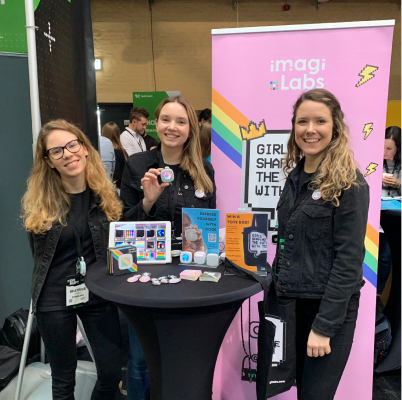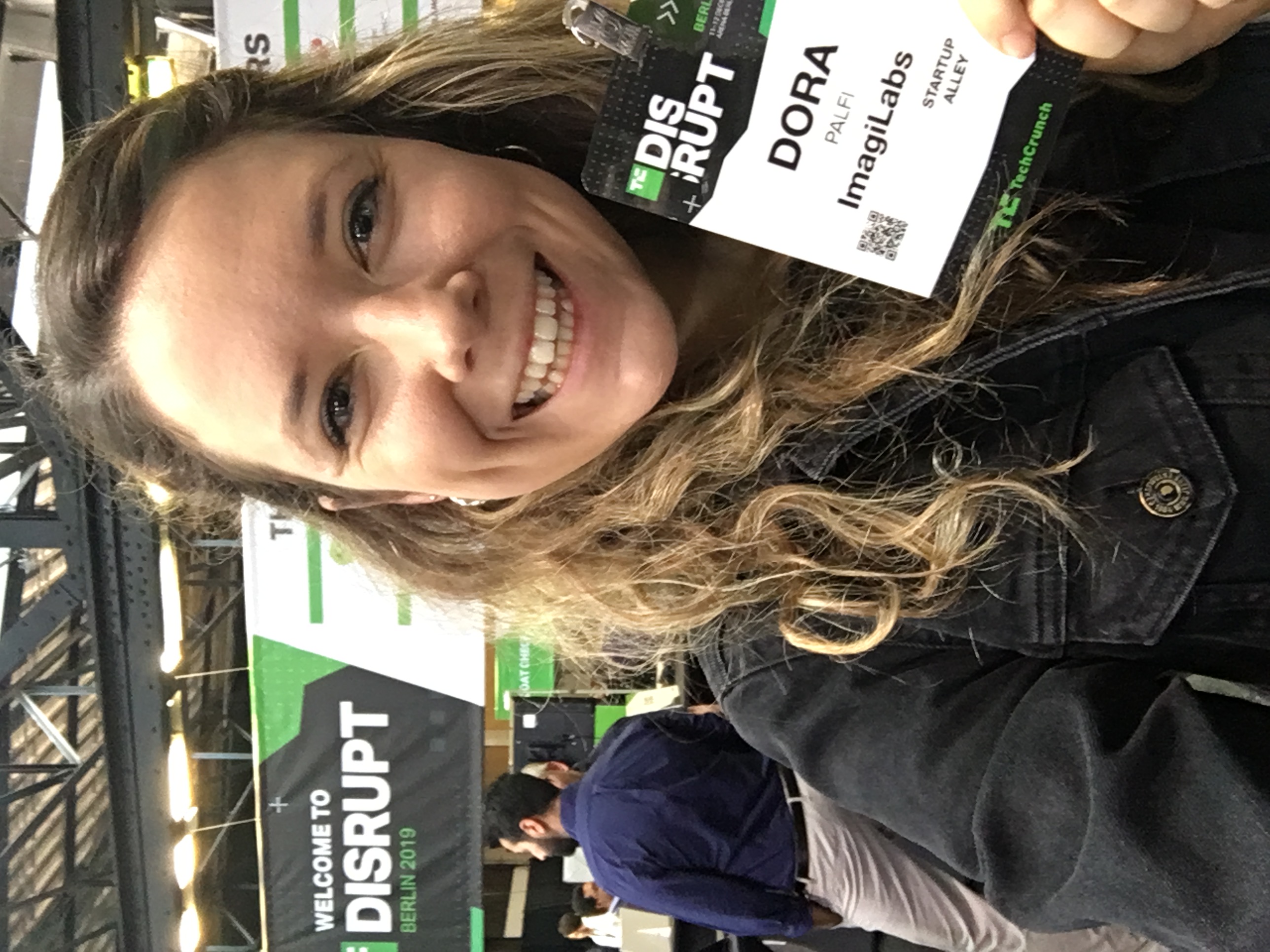EIT Digital Alumni Startup Contest (a.k.a. Ambassador Program) is a continuously hosted competition by the Alumni Foundation, aiming to stimulate the entrepreneurship in our community. Startup imagiLabs won the Startup Contest 2019, thus its co-founder Dora and her team got a covered trip to TechCrunch Disrupt Berlin. Now Dora is summarising this trip and sharing her insights with fellow alumni.
Early November an opportunity presented itself: we could attend Disrupt Berlin, organized by TechCrunch, as the winner of the Alumni Startup Contest! Amazing news, isn’t it? Not so quickly… Recently, I have been thinking a lot about startup events and whether it is “worth'' attending. Before starting imagiLabs, startup events were thrilling, inspiring, a great opportunity to meet people. However, recently I started to question whether it is the best use of my resources. And when I say resources, I think of the two main things I am short on as a startup founder - time & money. If you want to be very pragmatic you could simply think of it as an equation:

Thanks to the Alumni Foundation, the financial burden was completely removed from this equation and we decided that we can make the time commitment more than worthwhile - if we do it right!
First of all, like with anything else we do as a company, we had to clarify the why, why are we attending Disrupt Berlin and that is, what is the expected outcome we can plug into the above equation? We had a plan to achieve 3 main things: getting visibility, finding investors/relevant mentors and finding knowledge and inspiration.
So, rather than writing a summary of what the conference was like, here is the playbook we came up with for a positive outcome - and I hope this can be of help for other founders as well!
Getting Visibility
Thanks to the Alumni Foundation support, we could actually get a Startup Alley exhibitor pass at the event, meaning that we had a small booth for the first day. When it comes to tech conferences I would say having a booth and/or a chance to speak on stage can really help with gaining more visibility through the event.

When it comes to the booth - our rather different brand and design from the surrounding startups definitely helped, including our on-brand stickers, business cards and give-away. Something we always try to do at events is having a clear call-to-action (CTA) for the visitors of our booth: follow us on Instagram, sign up for our newsletter or (if we stumble on the perfect target customer) pre-order the imagiCharm. Soon, once our product is out, the CTA will be to download the imagiLabs app and buy on imagiCharm - I really can't wait!
However, for a successful CTA you have to understand who the audience will be, before the conference. I have to admit, we didn't exactly guess right what the audience would be like. In our universe after spending so much time with teenagers, Instagram is the number one social media platform but it turns out that a very low percentage of Disrupt visitors use Instagram, but we managed to react quickly while at the event.

(Agnieszka Hryniewicz-Bieniek, Director at Google for Startups also stopped by our booth)
But while we didn't get the target audience quite right we did have something going for us which I call the imagiLabs bonus! We have a physical product that in itself catches attention and we always walk around in our jackets at tech conferences. What better way to stand up for what we believe in? These jackets have initiated countless conversations and pictures.
Something else we did was to step up our social media activity on all channels before and during Disrupt. It could be that someone in our network or in their network is also attending the event! This is for example how we connected with @50intech (a platform for women in tech) first over Twitter and then in person!
Finding investors/mentors
I would have never imagined how much effort goes into making the most out of a tech conference both before and after the event itself. TechCrunch does a lot of work to assist you through their Crunch Match app - you can search for participants in advance and book meetings, and they even have a meeting area with tables that you get assigned!
But with so many attendees it can be quite paralysing to search for potential meetings. In my case, I set my sights on finding relevant investors and potential mentors. And by this, I don't mean trying to book a meeting with every single investor present. I understand that investors are also busy people and we shouldn't waste each other's time if we are not relevant to each other! So a quick googling for their website/LinkedIn, the type of companies they have invested in (and at what stage they invested) does the trick.
Once at the event, during meetings I like to take notes, be that on paper or my phone, as it is so easy to forget what conversation you just had in such a high-intensity and quick-paced environment.
But doing all that work - booking meetings, taking notes, would all be worthless if you don't make the effort to follow up. Which is why, after the second day of Disrupt, we actually spend time collecting all the contacts we made, following up and sharing notes with each other in our team. Not the most exciting thing to do but definitely a worthwhile exercise.
Finding knowledge and inspiration
I have heard people say don't waste your time going to talks during the conference - you can watch them from home! But let's be honest, how often do we actually sit down and (re)watch conference talks? I find that picking out the most relevant and interesting talks and being fully present always makes the events more exciting. At Disrupt I attended the startup battlefield pitches and "pitch deck teardown". The former was a great opportunity to learn from other founders, not just how they pitch but also how they respond to the "typical" investor questions and the latter had a setup I never experienced before: 4 investors on stage going through and commenting on 5 startup decks. No representative of the startup on stage, it is a pure simulation of what it's like from an investor's perspective to receive your presentation. It was filled with practical tips such as linking your LinkedIns to every team member's name on the team slide or making decks easily readable on phones (because oftentimes they get looked at on the go!). We also attended a talk by the European Innovation Council EU Funding for Startups. Any fellow founders reading this blog post? Make sure to check it out!
How to do it all?
The imagiLabs twist on it: I give all respect to solo founders, I can't even imagine how they do it - in their every day and at conferences! I am so truly lucky to have two co-founders with whom we can divide and conquer. Split tasks, split focus - while one of us was in charge of the booth, the others could attend talks and meetings; when we needed a change, we simply switched it up!
Does all of this sound a bit too planned and boring? I agree, and the truth is you cannot always be so rational and strategic about everything. In the end, you also have to be open to random encounters! Something I finally learned after several conferences are to aim to be fully present, and not expect to "get work done" while you are at the venue. After all, you are surrounded with hundreds of interesting and inspiring professionals and you never know what insight a chat in line for lunch of coffee will hold!
Finally, in-between the busy schedule I also found a minute to step back and take a big smile, wow we are at Disrupt Berlin! I remember watching the HBO show Silicon Valley way before I even considered starting a startup, and during one of the episodes the main characters attended Disrupt San Francisco. It seemed thrilling and it seemed so distant from anything I would ever do! Perhaps next year we get to pitch on the Disrupt stage like Pied Piper did but at least I also planted some pineapples this year. (If you don't get the reference go check out Silicon Valley - I don't often promote TV shows but I definitely think this one is a very accurate representation of the extreme rollercoaster ride startup founders sign up for).


(Excited about Disrupt Berlin & an imagiCharm with a pineapple programmed onto it!)
There is probably so much we could do differently/better when it comes to tech events and we love learning from others! Let us know your comments and tips and if we are ever at the same tech conference make sure to say hi!
Thank you for reading and thank the Alumni Foundation for the opportunity!
Dora Palfi is an EIT Digital alumna. She studied Human-Computer Interaction at KTH in Stockholm. Dora is the co-founder and CEO of imagiLabs.
